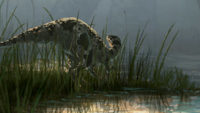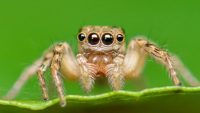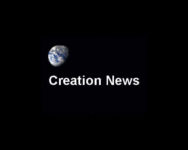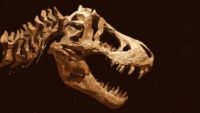Neo-Darwinism, Neutral evolution, and the ‘Extended Evolutionary Synthesis’ cannot avoid the multilayered complexity of the genome and cell. …read more Source: creation.com
News reports reverberated with details from a fantastic new fossil site in southern China.1 The Cambrian remains supposedly represent some of the earliest creatures to have evolved on Earth, but two telling details show why these fossils fit better with biblical creation. Researchers described in the journal Science the unique set of animals buried in black Cambrian siltstone l… More… …read more Source: icr.org
Robotics engineers trying to copy human bipedal locomotion have a long way to go …read more Source: creation.com
How has God used ICR to draw people to Christ? Why do we find marine and dinosaur fossils mixed together? How should Christians respond to climate change alarmism? And what can we learn about our Creator when we study ecology? Discover the answers to these questions and more in the April 2019 issue of Acts & Facts! More… …read more Source: icr.org
Can opals and opalised fossils form quickly under the right conditions? …read more Source: creation.com
By Troy Lacey A recent study was published purporting to explain how snakes lost their limbs, and it revealed some surprising findings. …read more Source: AIG Daily
By Ken Ham After examining a fossil left in a box in storage for ten years, scientists made a surprising discovery—this fossilized bird, found in lower Cretaceous sediment, was preserved with her unlaid egg still inside her. There was also evidence of medullary bone, “a calcium-bearing tissue that aids in eggshell formation.”1 This is strong support for the idea that so-called ancient birds (this one dated at a supposed 110 million years) created and laid eggs in a similar fashion to today’s birds. The scientific paper on this find, published in Nature Communications, is unequivocally reporting on a true …read [More]
By Dr. Marcus Ross In all the hoopla about the really big dinosaurs, the little ones get forgotten. …read more Source: AIG Daily
By Troy Lacey Paleontologists working in the Jinju Formation (Early to Mid-Cretaceous) in southeast South Korea discovered ten well-preserved spider specimens in shale. …read more Source: AIG Daily
The erosion that occurred during the latter stages of Noah’s Flood is almost unimaginable, but remarkably obvious. …read more Source: creation.com
Why are man-made pills increasingly ineffective in the battle against infections? …read more Source: creation.com
Every person is an important ecosystem for a wide variety of microorganisms. Whether it’s the bacterial collection of coliforms in our large intestine, streptococci in our mouth, or the diptheroids on our skin, it’s the normal flora or normal microbiota. The microbial colonization of our gut, for example, supports the digestion of complex nutritional components and activates anatomical changes of the intestine. This total collec… More… …read more Source: icr.org
In wrestling with the overwhelming evidence of design around us, atheists propose explanations somewhere beyond this world; even in imagined other universes. …read more Source: creation.com
By Ken Ham In 1955, more than a dozen strange-looking killer whales were stranded on a beach in New Zealand. Called “type D” killer whales, they were virtually unknown in the wild to science, except in a few photographs and fisherman stories, from that time on. But, as National Geographic reports, scientists have now observed a pod of these whales for the first time. Scientists headed for the dangerous waters off the tip of South America where these whales reportedly patrol the seas. After waiting for a week, a pod of whales finally approached the anchored research vessel. Scientists were [More]
By Ken Ham Order your copy of Glass House: Shattering the Myth of Evolution today! You see, God created organisms to reproduce according to their kinds. Cats produce cats, dogs produce dogs, and elephants produce elephants. But God built tremendous genetic diversity into the DNA of every kind that he made. This allows them to spread out and fill the earth, adapting to different ecological niches. That’s why we can have wolves that thrive in the cold arctic, coyotes that scavenge at the local city dump, and dingoes that hunt on the grasslands and deserts of Australia. They’re all dogs, [More]
The incredible basilisk has an amazing ability that allows it to skim across the water. …read more Source: creation.com
By Dr. Marcus Ross Contrary to popular portrayals of T. Rex as an ungainly brute who lumbered onto the scene millions of years ago, he was regally designed. …read more Source: AIG Daily
Well-funded YouTube video falls far short in explaining how consciousness evolved …read more Source: creation.com
Recent headlines claim, “Scientists Have Witnessed a Single-Celled Algae Evolve Into a Multicellular Organism.”1 In reality, the experiment showed that nothing more than a crude clumping together of individual cells had occurred. A new multicellular organism was not created, nor was any real evolution observed. One of the major hurdles in the grand story of molecules to man evolution is how life… More… …read more Source: icr.org
A new study by NASA scientists has just been published where researchers did nothing more than convert a pre-cursor chemical into a single type of amino acid. Despite the simplicity of this experiment and the lack of anything helpful to evolution being found, the popular media exclaimed that the scientists were able to “recreate the ‘origins of life’ and the results are shocking.”1,2 In reality, the only t… More… …read more Source: icr.org
God tells us in Genesis how and when He created the heavens and the earth. It wasn’t by means of a bang no matter how big. …read more Source: creation.com
The amazing changes in a new born baby’s circulation …read more Source: creation.com
By Ken Ham A recent article from Live Science reports on new reconstructions at the American Museum of Natural History in New York City that claim to be “the most accurate models of [T. Rex] to date.” And this new reconstruction features baby T. Rex as a turkey-sized ball of fluffy feathers. But did T. Rex and other dinosaurs feature a covering of feathers? Today’s narrative is that birds are really dinosaurs, an idea supposedly supported by so-called feathered dinosaurs. Evolutionists increasingly cover nearly every dinosaur species in fluffy feathers. Today’s narrative is that birds are really dinosaurs, an idea [More]
Evolutionists claim that an eight-letter DNA alphabet called hachimoji allows for more varied evolution of life, but simple science shows otherwise. Read More
Below the sea around land masses there is evidence of rapid water run-off, not slow and gradual erosion. …read more Source: creation.com
One of the most complex biochemical processes in God’s creation is the ability plants possess to take in carbon dioxide and water and, with the aid of sunlight, turn it into energy-rich sugars. Most of us learned about this amazing process called photosynthesis in school. It’s designed to be the route by which virtually all energy enters Earth’s ecosystems. If you have studied photosynthesis, you can appreciate ju… More… …read more Source: icr.org
Can random DNA sequences be a source of evolutionary novelty? …read more Source: creation.com











































